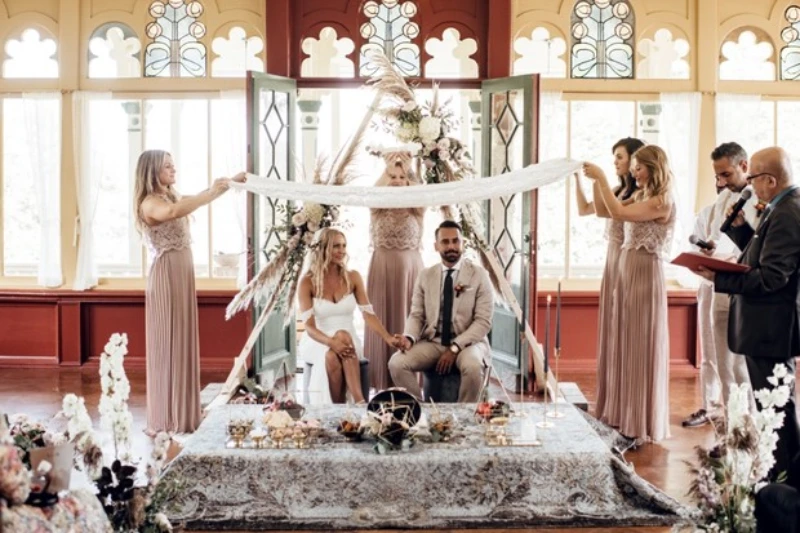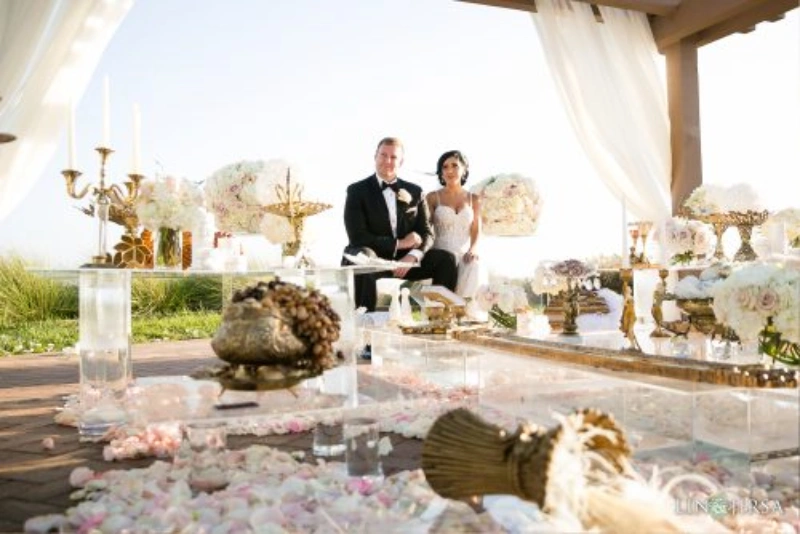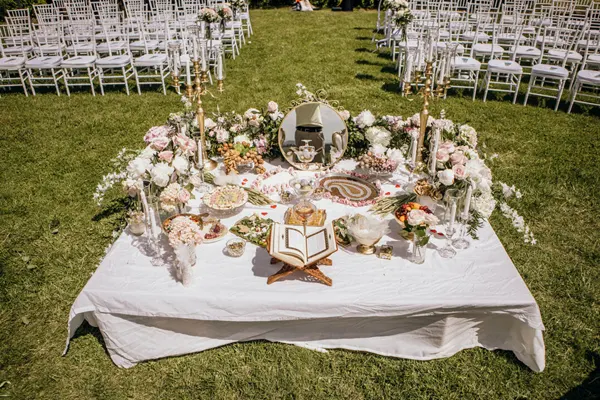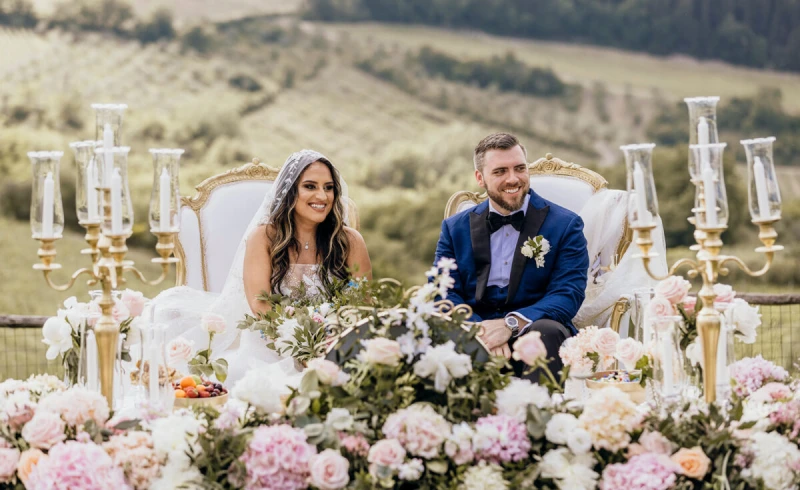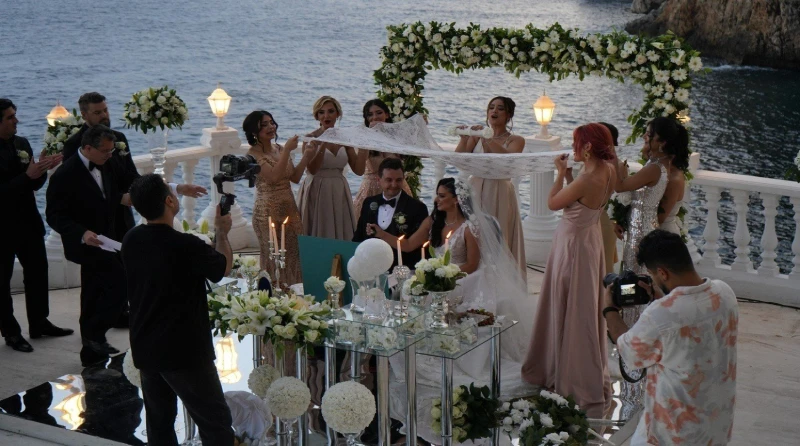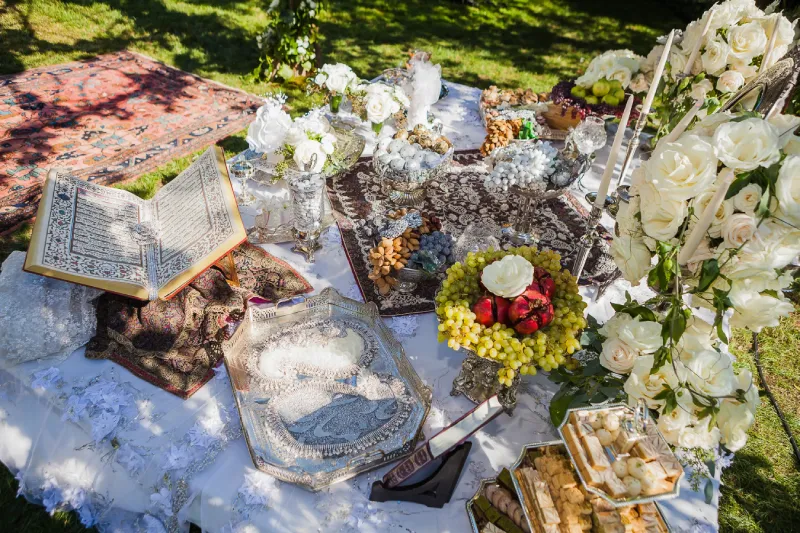Persian weddings are a vibrant tapestry of tradition and modern flair, offering couples a unique way to celebrate their love. If you’re at a crossroads, deciding between the enchanting customs of a traditional Persian wedding and the sleek sophistication of modern celebrations, you’re not alone. Each style carries its distinct charm and significance, reflecting centuries of rich culture and evolving trends. Traditional ceremonies boast intricate rituals, from the mesmerizing Sofreh Aghd spread to the timeless dance of the bride and groom, while modern weddings embrace contemporary aesthetics, blending global influences with personal touches. In this article, we’ll explore the essence of both traditional and modern Persian weddings, weighing their benefits and unique elements. Whether you’re drawn to the vibrant colors and meaningful gestures of tradition or the sleek elegance of a modern approach, discovering what’s right for you will be an exciting journey into love and celebration. Let’s dive in and find the perfect match for your dream wedding!
Key Elements of a Traditional Persian Wedding Ceremony
Traditional Persian weddings are steeped in history and cultural significance, with each element thoughtfully curated to honor ancestral customs. Central to the ceremony is the Sofreh Aghd, an elaborate spread that symbolizes various aspects of the couple’s future life together. The Sofreh Aghd includes items like mirrors and candles to signify light and clarity, and sweets to represent the promise of sweetness in the couple’s life. The ceremony is often conducted by a “mobed,” or Zoroastrian priest, who recites ancient prayers and blessings, imbuing the occasion with sacred meaning.
Another defining feature is the “Aghd,” the actual marriage contract ceremony, which involves the bride and groom exchanging vows and signing a legal document in front of witnesses. This formalization is not just a legal necessity but a deeply spiritual act, solidifying the union in the eyes of both the law and the divine. The bride’s consent is traditionally sought multiple times, often with her remaining silent initially as a sign of modesty and respect, before finally giving her affirmative answer, which is met with joyous cheers and celebrations.
The reception, or “Jashn-e Aroosi,” follows the Aghd and is a grand affair characterized by lavish feasts, music, and dance. It’s a time for the bride and groom to celebrate with their extended families and friends, often featuring traditional Persian music and dance performances. The highlight is usually the “Raghs-e-Chaghoo,” or knife dance, where guests take turns dancing before the bride and groom, playfully withholding the cake-cutting knife until they receive a token or monetary gift. This blend of solemnity and festivity encapsulates the essence of a traditional Persian wedding.
How Modern Persian Weddings Are Evolving in 2025
Modern Persian weddings are evolving to reflect contemporary tastes and lifestyles while still paying homage to cultural roots. In 2025, these weddings are marked by a blend of minimalist aesthetics and high-tech enhancements. Couples are increasingly opting for sleek, elegant venues that offer a blank canvas to personalize their celebration. Think rooftop terraces with stunning city views or industrial-chic lofts adorned with lush greenery and modern art installations. These settings provide a sophisticated backdrop that contrasts with the opulence of traditional Persian weddings.
Technology plays a significant role in modern Persian weddings, enhancing both the ceremony and the reception. From live-streaming the event for distant relatives to drone photography capturing aerial views, the incorporation of cutting-edge technology adds a futuristic touch. Interactive elements like digital guest books, photo booths with instant social media sharing, and personalized wedding apps that keep guests informed and engaged are becoming standard. These innovations make the celebration more inclusive and memorable for everyone involved.
Despite the modern trappings, many couples strive to retain certain traditional elements, creating a hybrid ceremony that honors the past while embracing the present. For example, the Sofreh Aghd might be reimagined with contemporary designs and minimalist decor, but the symbolic items remain. Modern couples are also more likely to personalize their vows, making the ceremony more intimate and reflective of their unique journey. This blend of old and new ensures that the wedding is both meaningful and relevant.
Sofreh Aghd: Classic Symbolism vs Contemporary Styling
The Sofreh Aghd is the heart of a Persian wedding, embodying rich symbolism and cultural heritage. Traditionally, the Sofreh Aghd includes items like a mirror to reflect the bride and groom’s future, candles for light and energy, and various spices and herbs to ward off evil spirits. These elements are arranged in an intricate and aesthetically pleasing manner, often passed down through generations. The traditional Sofreh Aghd is a visual feast, brimming with historical significance and familial pride.
In contrast, contemporary Sofreh Aghd setups are often streamlined to match modern aesthetics while retaining their symbolic essence. Instead of elaborate, ornate displays, couples might choose minimalist arrangements with clean lines and monochromatic color schemes. The items on the Sofreh Aghd are chosen with equal care, but the presentation is more aligned with current design trends. For instance, modern Sofreh Aghd might feature geometric shapes, metallic accents, and fresh floral arrangements that complement the overall wedding theme.
This evolution reflects a broader trend in modern Persian weddings, where tradition and innovation coexist harmoniously. Couples today are more likely to customize their Sofreh Aghd to reflect their personal style and values. This could mean incorporating elements that are unique to their relationship or heritage, such as family heirlooms or mementos from their travels. Whether traditional or contemporary, the Sofreh Aghd remains a powerful symbol of the couple’s commitment and shared future.
Choosing Between a Cultural Venue and a Modern Setting
Selecting the perfect venue is one of the most crucial decisions in wedding planning, and this is particularly true for Persian weddings. Traditional cultural venues, such as historic mansions, gardens, or community halls, offer a deeply rooted connection to heritage. These locations often come with a sense of nostalgia and authenticity, providing a fitting backdrop for the time-honored rituals and ceremonies. The architecture and ambiance of cultural venues enhance the overall experience, making the wedding feel like a continuation of cherished traditions.
On the other hand, modern settings offer a fresh canvas that can be tailored to the couple’s vision. Contemporary venues like chic hotels, art galleries, or urban lofts provide flexibility and a touch of sophistication. These spaces are ideal for couples who want to incorporate modern design elements and technology into their celebration. The versatility of a modern venue allows for creative freedom, from the decor and lighting to the layout and flow of the event. Additionally, modern venues often come equipped with state-of-the-art amenities, ensuring a seamless and comfortable experience for guests.
Ultimately, the choice between a cultural venue and a modern setting depends on the couple’s priorities and personal style. Some might find solace in the familiarity and warmth of a traditional venue, while others might be drawn to the sleek elegance and adaptability of a modern space. It’s also possible to strike a balance by choosing a venue that offers the best of both worlds—such as a historic site with modern facilities. Whatever the decision, the venue sets the tone for the entire wedding, making it a pivotal aspect of the planning process.
Persian Wedding Attire: Traditional Looks vs Trendy Designs
Wedding attire is a central aspect of any celebration, and Persian weddings are no exception. Traditional Persian bridal attire is characterized by its luxurious fabrics, intricate embroidery, and vibrant colors. The bride often wears a “jameh,” a long gown adorned with elaborate gold or silver threadwork, accompanied by a matching veil and headpiece. These garments are not only visually stunning but also imbued with cultural significance, often featuring patterns and motifs that symbolize good fortune and prosperity.
In contrast, modern Persian brides are increasingly opting for contemporary designs that reflect their personal style while still honoring their heritage. This might mean choosing a sleek, minimalist gown with subtle nods to traditional elements, such as lace detailing or beaded embellishments. Some brides even opt for bespoke creations that blend modern silhouettes with traditional craftsmanship, resulting in unique and personalized ensembles. Grooms, too, are experimenting with their attire, moving beyond the classic black tuxedo to explore bolder colors, patterns, and accessories.
This evolution in wedding attire reflects a broader shift towards individual expression in modern Persian weddings. While traditional garments hold a timeless appeal, contemporary designs offer couples the opportunity to make a statement and showcase their unique personalities. Whether donning a classic jameh or a chic modern gown, the key is to choose attire that feels authentic and resonates with the couple’s vision for their special day. In doing so, they create a visual narrative that complements the overall theme and ambiance of their wedding.
Mixing Tradition with Innovation in Persian Wedding Entertainment
Entertainment is a cornerstone of Persian weddings, providing a lively and joyous atmosphere for guests to celebrate. Traditional Persian wedding entertainment often includes live music performed by skilled musicians playing instruments such as the tar, santour, and daf. The music sets the tone for various rituals and dances, including the iconic “Raghse Bandari,” a lively and energetic dance that encourages guests to join in. These performances not only entertain but also connect guests to the cultural heritage and collective joy of the occasion.
In modern Persian weddings, entertainment has evolved to include a mix of traditional and contemporary elements. DJs and live bands that play a fusion of Persian and Western music are increasingly popular, catering to diverse tastes and ensuring that the dance floor remains packed throughout the night. Interactive entertainment options, such as photo booths, caricature artists, and live painting, add a unique twist and provide memorable experiences for guests. These modern touches enhance the celebratory atmosphere and create a dynamic and engaging event.
Balancing tradition with innovation in wedding entertainment allows couples to create a celebration that is both meaningful and enjoyable. Incorporating traditional music and dances honors the cultural roots of the ceremony, while modern entertainment options add an element of surprise and personalization. This blend ensures that all guests, regardless of age or background, feel included and entertained. By thoughtfully curating the entertainment, couples can craft a wedding experience that resonates with their heritage while reflecting their contemporary tastes.
How to Balance Family Expectations with Personal Style
Navigating family expectations while planning a wedding can be a delicate balancing act, particularly in Persian culture where familial involvement is paramount. Traditional Persian weddings are often seen as a celebration not just of the couple but of their families coming together. This can lead to strong opinions and expectations from parents and elders regarding various aspects of the ceremony, from the choice of venue and attire to the rituals and guest list. Understanding and respecting these expectations is crucial for maintaining harmony and honoring cultural traditions.
At the same time, modern couples are increasingly seeking to infuse their weddings with personal style and individuality. This might involve incorporating non-traditional elements, such as a unique theme or unconventional attire, or simplifying certain rituals to better reflect their values and lifestyle. Finding the right balance between honoring family traditions and expressing personal style requires open communication and compromise. Couples should take the time to discuss their vision with their families, explaining the significance of certain choices and seeking their input and blessings.
One effective approach is to identify key areas where tradition is particularly important and ensure that these are respected, while finding opportunities to personalize other aspects of the wedding. For example, the couple might choose to adhere to traditional rituals during the ceremony but opt for modern decor and entertainment at the reception. By involving family members in the planning process and showing appreciation for their input, couples can create a wedding that honors their heritage while reflecting their unique identity. This collaborative approach fosters a sense of unity and shared celebration.
Cost Differences Between Traditional and Modern Persian Weddings
The financial aspect of wedding planning is a significant consideration for many couples, and understanding the cost differences between traditional and modern Persian weddings can help in making informed decisions. Traditional Persian weddings, with their elaborate rituals and ornate decor, can be quite costly. The Sofreh Aghd setup, traditional attire, and cultural entertainment all contribute to the overall expense. Additionally, traditional venues, which are often historic or culturally significant locations, can come with a higher price tag.
In contrast, modern Persian weddings can offer more flexibility in terms of budget. Contemporary venues and minimalist decor can help reduce costs, allowing couples to allocate their budget towards other priorities, such as high-quality catering or innovative entertainment options. Furthermore, modern weddings often benefit from technological advancements, such as digital invitations and online RSVPs, which can help streamline expenses. However, it’s important to note that certain modern elements, such as high-end photography or custom-designed attire, can also add to the overall cost.
Ultimately, the cost of a Persian wedding—whether traditional or modern—depends on the couple’s priorities and choices. Some couples might find value in investing in traditional elements that hold deep cultural significance, while others might prioritize creating a modern, personalized experience. Setting a clear budget and identifying non-negotiable aspects can help in making balanced and thoughtful decisions. By doing so, couples can ensure that their wedding is both meaningful and financially manageable.
Finding the Perfect Blend for Your Unique Persian Celebration
Creating a wedding that reflects both tradition and modernity is an art, and finding the perfect blend requires thoughtful planning and creativity. One approach is to start with the core elements that are most important to the couple and their families. This could include key rituals, traditional attire, or cultural symbols that hold significant meaning. From there, couples can explore ways to incorporate modern touches that enhance the overall experience without overshadowing the traditional aspects.
For example, a couple might choose to have a traditional Sofreh Aghd ceremony but opt for contemporary floral arrangements and minimalist decor. They could also blend traditional Persian music with modern genres, creating a dynamic and inclusive atmosphere for guests of all ages. Personalized elements, such as custom vows or unique wedding favors, can add a special touch and make the celebration truly one-of-a-kind. By thoughtfully integrating these elements, couples can create a wedding that honors their heritage while reflecting their personal style.
Collaboration is key in achieving this balance. Involving family members in the planning process and seeking their input can help ensure that traditional aspects are respected and cherished. At the same time, couples should feel empowered to make choices that resonate with their vision and values. Open communication and a willingness to compromise can lead to a harmonious and memorable celebration that bridges the past and the present. In doing so, couples create a wedding that is not only a reflection of their love but also a celebration of their unique cultural journey.
Conclusion: Finding Your Perfect Wedding Balance
Choosing between a traditional and modern Persian wedding is a deeply personal decision, and there is no right or wrong answer. Both styles offer unique opportunities to celebrate love, heritage, and individuality. Traditional Persian weddings provide a rich tapestry of rituals and symbolism, connecting couples to their cultural roots and creating a sense of continuity and belonging. Modern Persian weddings, on the other hand, offer flexibility and creativity, allowing couples to craft a celebration that is uniquely their own.
The key to finding the perfect balance lies in understanding what aspects of the wedding are most important to the couple and their families. By identifying these priorities and being open to compromise, couples can create a wedding that honors tradition while embracing contemporary elements. Whether it’s through the choice of venue, attire, or entertainment, thoughtful planning and collaboration can lead to a harmonious and memorable celebration.
Ultimately, the most important aspect of any wedding is the love and commitment between the couple. By focusing on this central theme and infusing the celebration with personal touches and meaningful traditions, couples can create a wedding that is both timeless and modern. In doing so, they not only honor their heritage but also pave the way for new traditions and memories that will be cherished for generations to come.

